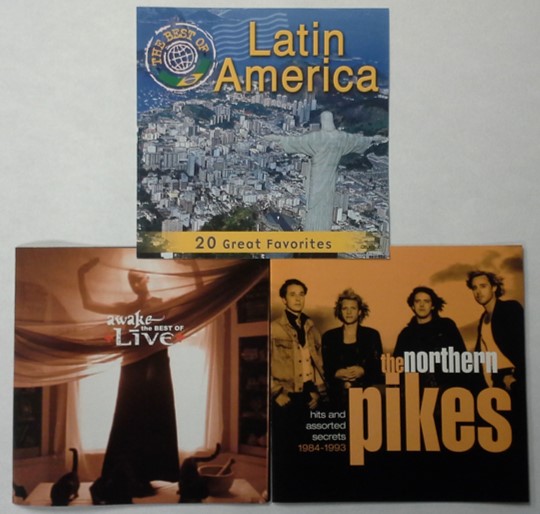- Home
- Storage of Discs
- CD Album Covers
CD Album Covers
CD album covers and cd jewel case inserts are those glossy pages that are found in the CD jewel case. This type of material can be found inserted in the top cover of the jewel case and/or underneath the holding tray. For slim jewel cases, the inserts are only found on the top part of the case.
Basically, there are three types of CD jewel case inserts.
Audio CD Booklets or Liner Notes
Audio CDs often come with booklets that contain a variety of information. The top of these booklets, which are readily visible, include some kind of album artwork and contain the artist and album name. Some examples of these audio CD booklets, or liner notes as they are often called, are provided below.

This is similar to what was done with the LPs, some of which contained very interesting and extensive artwork. Inside of the booklet, a variety of information is presented in addition to the song list. There is no standard as to what type of information is included, but it may be photos of the band, historical information of the band, song lyrics, artist profiles, background information on the songs, credits, acknowledgements, and more. The insert underneath the tray almost always contains the list of audio tracks on the disc.
Some of these booklets can be quite extensive and be comprised of several pages, whereas others may only be a page or two.
Manufacturer's Branding and Information
The second type of CD album covers or CD jewel case inserts are found with recordable or erasable optical media. These jewel case covers are the manufacturer’s labeling and include the manufacturer’s name, type of disc, rated recording speed of the disc, disc recording capacity, and other marketing information.

Homemade Album Covers
The third type is a CD album cover insert that you produce yourself to decorate and label or identify the jewel case that contains a disc with recorded information such as digital photos, digital videos, etc.
CD Album Covers and Long-Term Storage
When it comes to the long term storage of CDs, DVDs, Blu-rays, and other optical discs, is it a good idea to leave these CD album covers in the case with the disc?
As a general archival rule, it is not a good idea to store paper materials in with the media. This is especially true if the paper materials are poor quality acidic materials. The CD album covers are not acidic in nature but are alkaline. However, the jewel case inserts are very glossy and the long term effects of the inks and all the additives used to produce these glossy inserts is unknown. ISO standard 18938:2014 Imaging materials - Optical discs - Care and handling for extended storage states the following:
For long-term disc storage, it is recommended to remove the label insert or booklet from inside the case and attach it to the outside. Paper can produce higher moisture content in the case, and many release harmful pollutants or in certain conditions adhere to the disc. These potentially harmful affects depend on relative humidity conditions and the insert material properties, as well as their proximity to the disc.
Therefore, because in most situations optical discs are not stored under ideal conditions and do experience higher temperatures and humidity levels than recommended, it is probably a good idea to follow the recommendations as outlined by the standard above. Note that there has been no evidence that the CD album covers do contribute to the degradation of audio CDs. For these one might consider leaving the material in the case, but only if the storage conditions are not hot and humid. However, recordable media are different in terms of their construction and the recording layers (composed of dyes) may be more sensitive to components being emitted from the inserts. For some of these recordable optical discs, it is recommended to remove all the manufacturer’s insert materials and to not place any of your own printed paper materials in the jewel case. Place your designed CD jewel case covers on the outside of the case for maximum safety.
Scientific Research on Paper Enclosures in Jewel Cases
To alleviate some of the uncertainty with respect to paper materials being included in the jewel with the disc or not, some scientific research has been performed. The study looked at the effects of storage enclosures on CD formats. This research confirmed that in some cases the paper materials can be left in the case with the disc, whereas in other situations the paper should be removed. This paper is entitled, "The Effect of Jewel Cases on the Stability of Optical Disc Media."
More specifically, the study indicated:
- to avoid inserting poor quality acidic papers in the case with the CD
- alkaline paper materials can remain in the jewel case for phthalocyanine dye/gold metal CD-Rs, phthalocyanine dye/silver metal CD-Rs, and audio or read-only CDs
- alkaline paper materials should be removed from inside of the jewel case for cyanine dye/silver metal CD-Rs and azo dye/silver metal CD-Rs
- the effect of paper inserts on DVD-Rs was not investigated and therefore, there are no specific recommendations for these formats; therefore the recommendations in the standard should be followed.
Once again to emphasize the point, if you must include jewel case covers in the case, then the CD-R with gold metal layer and phthalocyanine dye should be used. The inclusion of any type of insert materials (even poor quality) is not an issue with these discs because the disc components are very stable. The same can be said to a certain extent for the DVD-R disc that uses the gold metal layer.